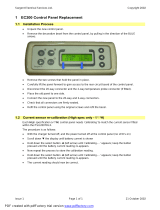
13
Protection
Locate the Pump Unit, the ECU and the Compass Ball in a place where they will not be submerged or exposed to wash
down. Spray the installed components with a protective corrosion prohibitive like Bo-Shield or Corrosion X, etc.
Hydraulic Connections
Before starting the hydraulic installation, please verify the type of hydraulic steering in the boat. If it does not match the
hydraulic layouts in this manual, call technical support at 1-866-559-0229 for specic installation procedures. Examples of
steering systems that may need special instructions: Capilano, Hynautic, Latham.
Do not use Teon tape on any hydraulic ttings. However, for leak free hydraulic system, we do advise you to use an
appropriate thread sealant such as, Loctite “Pro Lock” multipurpose anaerobic gel, part number 51604, or equivalent on all
pipe threads.
It is TR-1’s recommendation to only use hose with machine crimped on ttings, or eld replaceable ttings that have
a minimum of 1,000 PSI rating.
It is recommended that before connecting the hydraulic lines to the pumpset, ensure all the hydraulic lines in the steering
system have been ushed and that the hydraulic oil is free of any contamination, which may enter the pumpset or Shadow
Drive valve and cause it to fail.
Air in the hydraulic system will cause the autopilot not to function properly. It’s important to bleed the system thoroughly.
Follow the steering manufacturers instructions on bleeding procedures before proceeding with installation. You can nd
most of these instructions on the internet.
Hydraulic hoses must be protected from chang, and installed in such a way that they will not come in contact with sharp
objects such as fasteners or edges. Hydraulic lines must be secured wherever possible to prevent hose vibration while the
autopilot hydraulic pump is running.
Magnetic Environment
The Compass Ball has a very sensitive compass and gyro in it. Do not mount the ball near magnetic material, magnets
(speakers and electric motors), or high current carrying wires. Movable or changing magnetic disturbances such as anchors,
anchor chain, and wiper motors, tool boxes and the autopilot pump should be kept at least 24” away. A small handheld
compass may help in locating a magnetic free environment.
The Shadow Drive must not be mounted within 12” of any magnetic material such as speakers or electric motors, including
the autopilot pump.
Strain Relief and Cable Protection
Do not let the connectors on the ECU be the sole support for the cables connected to them. Use tie wraps to tie the cables
down.
Don’t run cables and hoses over sharp edges. Use grommets in through holes to protect cables.
Maintenance
J
ust like other electronic equipment, the TR-1 Gladiator should be protected against corrosion. Since most of the components
are out of sight, out of mind, you should coat all components with a spray on, electronic grade, protective corrosion inhibitor
like Bo-Shield, Corrosion X or equivalent. This should be done after installation, and repeated every six months for best
protection, more often if components and connections are exposed to salt water. Check battery connections and fuse holder
for corrosion, and make sure all connections are tight.





















